Employment of disabled people 2022
Published 26 January 2023
1. Introduction
These statistics relate to the employment of working-age disabled people in the UK. They provide context for the government’s goal to see one million more disabled people in work between 2017 and 2027. This goal was reached in 2022.
They also provide context for the government’s commitment to reduce the gap between the employment rates of disabled and non-disabled people (known as the disability employment gap).
This is the third annual publication and provides more detailed breakdowns of the labour market status of disabled people than those published on a quarterly basis by the Office for National Statistics (ONS). The need for these statistics was set out in the government’s strategy Improving lives: the future of work, health and disability published in November 2017.
This release contains annual data to March 2022 and quarterly data to September 2022.
2. Main points
Since 2013, the earliest comparable year, up to the start of the pandemic (March 2020) the general trend in disability employment has been positive. There has been strong growth in the number and rate of disabled people in employment and a narrowing of the gap between the rate of disabled and non-disabled people in employment (the disability employment gap).
The pandemic initially reversed these trends with year-on-year changes showing a fall in the disability employment rate and a widening of the disability employment gap in 2020. During 2021 and the first half of 2022 the rate and gap started to return to near pre-pandemic levels. However, the latest data for July to September 2022 shows the disability employment rate has fallen on the year with the non-disabled employment rate rising. This means that the disability employment gap is now at its widest point since 2018.
-
There were 4.9m disabled people in employment in the UK in July to September 2022. This is an increase of 240,000 on the year and an overall increase of 2.0m since the same quarter in 2013.
-
The disability employment rate was 52.6% in July to September 2022, compared to 82.5% for non-disabled people. For disabled people, this is a decrease of 0.8 percentage points on the year and an overall increase of 9.2 percentage points since the same quarter in 2013.
-
The disability unemployment rate was 7.2% in July to September 2022, compared to 3.2% for non-disabled people. For disabled people, this is a decrease of 0.3 percentage points on the year and an overall decrease of 7.3 percentage points since the same quarter in 2013.
-
The disability economic inactivity rate - where the person self-reports that they are not in or looking for work - was 43.3% in July to September 2022, compared to 14.8% for non-disabled people. For disabled people, this is an increase of 1.1 percentage points on the year and an overall decrease of 6.0 percentage points since the same quarter in 2013.
-
The disability employment gap was 29.8 percentage points in July to September 2022. This is an increase of 1.7 percentage points on the year and an overall decrease of 4.4 percentage points since the same quarter in 2013.
-
On average, between 2014 and 2019, around 340,000 disabled workers moved out of work each year and 380,000 workless disabled people moved into work (includes people who were classed as disabled at the start of the year).
-
This trend has been reversed in the last two years (2020 and 2021) with, on average, more disabled workers moving out of work (420,000) than moving in (350,000).
-
On average, between 2014 and 2021, disabled workers moved out of work at nearly twice the rate (8.9%) of non-disabled workers (5.1%). Workless disabled people moved into work at nearly one-third of the rate (9.7%) of workless non-disabled people (26.8%).
The increasing number of disabled people in employment (between 2013 and 2022) was driven by four main components of change: disability prevalence (60%); non-disabled employment rate (20%); disability employment gap (15%) and working age population (5%).
These statistics show that:
-
one in five of the working-age population were classed as disabled
-
the number of people reporting a long-term health condition or classed as disabled continues to rise
-
the rising number of people classed as disabled is associated with an increase in people reporting mental health conditions
-
nearly one in three people classed as being disabled one year were no longer classed as being disabled the next
The disability employment gap is wider for:
-
disabled men
-
older (aged 50 to 64) disabled people
-
disabled people with no qualifications
-
disabled people of White ethnicity
-
disabled people living in Northern Ireland, Scotland, Wales, North West, and North East
The disability employment rate is lower for disabled people:
-
with a mental health condition
-
with five or more health conditions
Disabled people were more likely than non-disabled people to be:
-
working in Health, Retail and Education
-
working in lower-skilled occupations
-
self-employed
-
working part-time (and subsequently less hours)
-
working in the public sector
-
working for a small employer
Disabled people were more likely to be economically inactive and for those that were:
-
the majority gave long-term sickness as their main reason for being inactive
-
they were more likely (than non-disabled people) to want a job
-
they were less likely (than non-disabled people) to have had a job in the last two years
3. What you need to know
Disability
Estimates by disability status in this release are for working-age people (aged 16 to 64 years) from April 2013 onwards. They use the Government Statistical Service (GSS) Harmonised Standard definition, in line with the Equality Act 2010 (EA) core definition. This includes people who have a long-term physical or mental health condition that affects their day-to-day activities. Estimates prior to April 2013, under different definitions of disability, are covered in-depth in the 2019 version of this publication.
Employment
Employment and other labour market concepts used in this release are defined in the same way as National Statistics published by the Office for National Statistics (ONS) in their Labour Market Overview. This in turn follows internationally agreed guidelines set out by the International Labour Organisation (ILO).
Seasonality
Quarterly estimates in this release are not seasonally adjusted. When comparing not seasonally adjusted data over time it is best practice to compare the same 3-month period for different years (for example, compare July to September 2013 with July to September 2022 but do not compare April to June 2013 with July to September 2022).
Data sources
Full definitions are given in the background information and methodology. Estimates in this release are based on versions of the Annual Population and Labour Force Surveys using the latest population weights.
The population totals used for the latest estimates use projected growth rates from Real-Time Information (RTI) data for UK, EU and non-EU populations based on 2021 patterns. The total population used therefore does not consider any changes in migration, birth rates, death rates, and so on, since June 2021, so levels estimates may be under- or over-estimating the true values and should be used with caution. Estimates of rates will, however, be robust.
Statistical significance
All results in the commentary are statistically significant at the 95% level, unless stated. Differences in employment of groups with given characteristics are not necessarily caused by those characteristics.
We can use statistical significance to decide whether we think a difference between two survey-based estimates reflects a true change in the population rather than being attributable to random variation in our sample selection.
Statistical significance helps us to establish what observed changes or relationships we should pay attention to, and which apparent changes may have occurred only because of randomness in the sampling.
A result is said to be statistically significant if it is likely not caused by chance or the variable nature of the samples. A defined threshold can help us test for change. If the test of statistical significance calculated from the estimates at different points in time is larger than the threshold, the change is said to be “statistically significant”.
A 5% standard is often used when testing for statistical significance. The observed change is statistically significant at the 5% level if there is less than a 1 in 20 chance of the observed change being calculated by chance if there is no underlying change.
Within the commentary of our statistical bulletins, we will avoid using the term “significant” to describe trends in our statistics and will always use “statistically significant” to avoid any confusion for our users.
Rounding
Figures contained within this release and are subject to additional rounding unless otherwise stated. The level of rounding applied, which is dependent on the magnitude of the figure being quoted, is shown in the table below.
Table showing statistical release rounding policy
| Range | Rounded to the nearest |
|---|---|
| 0 to 1,000 | 10 |
| 1,001 to 10,000 | 100 |
| 10,001 to 100,000 | 1,000 |
| 100,001 to 1,000,000 | 10,000 |
| 1,000,001 to 10,000,000 | 100,000 |
| 10,000,001 to 100,000,000 | 1,000,000 |
Users should note that percentages are calculated using numbers prior to rounding and rounded to one decimal place unless otherwise stated. Percentages therefore may not add up to 100%.
Accessibility
The supplementary data tables accompanying this release have been developed using Government Statistical Service (GSS) guidance on releasing statistics in spreadsheets. This is to improve the usability, accessibility, and machine readability of our data.
4. Measures
The next section looks at the three main measures used to monitor disability employment:
-
the (absolute) number of disabled people in employment
-
the disability employment rate (the number of disabled people in employment divided by the number of disabled people)
-
the difference between the employment rates of disabled and non-disabled people (known as the disability employment gap)
Trends for each measure, starting from April 2013, when the current definition of disability began, are shown in Figures 1 to 3. The components or factors that may influence these measures are examined in Figure 4.
The number of disabled people in employment continues to rise
Figure 1: Number of disabled people in employment, people aged 16 to 64, UK, April to June 2013 to July to September 2022
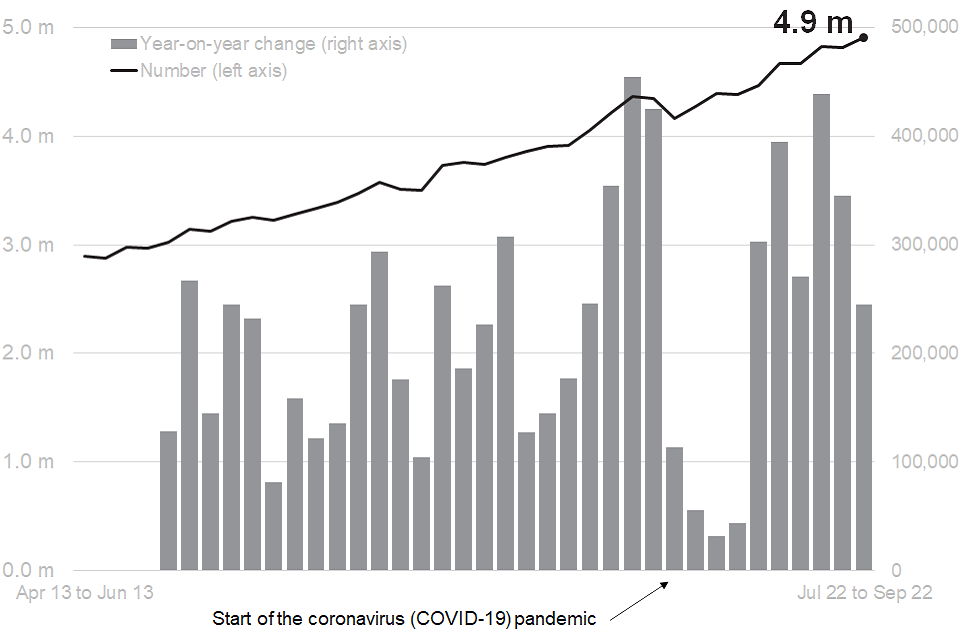
Source: Labour Force Survey – data and definitions can be found in supplementary data table MSR001
The number of disabled people in employment has increased by 2.0m from 2.9m in July to September 2013 to 4.9m in July September 2022 (an increase of 70.6%). The number continued to increase (year-on-year) throughout the coronavirus (COVID-19) pandemic but at a much slower rate. The increase has now returned to its pre-pandemic trend with 700,000 more disabled people in employment in July to September 2022 than there were in the same quarter in 2019.
The longer-term increases in disability employment can be linked to four main factors: disability prevalence; non-disabled employment rate; disability employment gap and working age population. See figure 4 for more details.
The disability employment rate has yet to return to its pre-pandemic trend
Figure 2: Disability employment rate, people aged 16 to 64, UK, April to June 2013 to July to September 2022
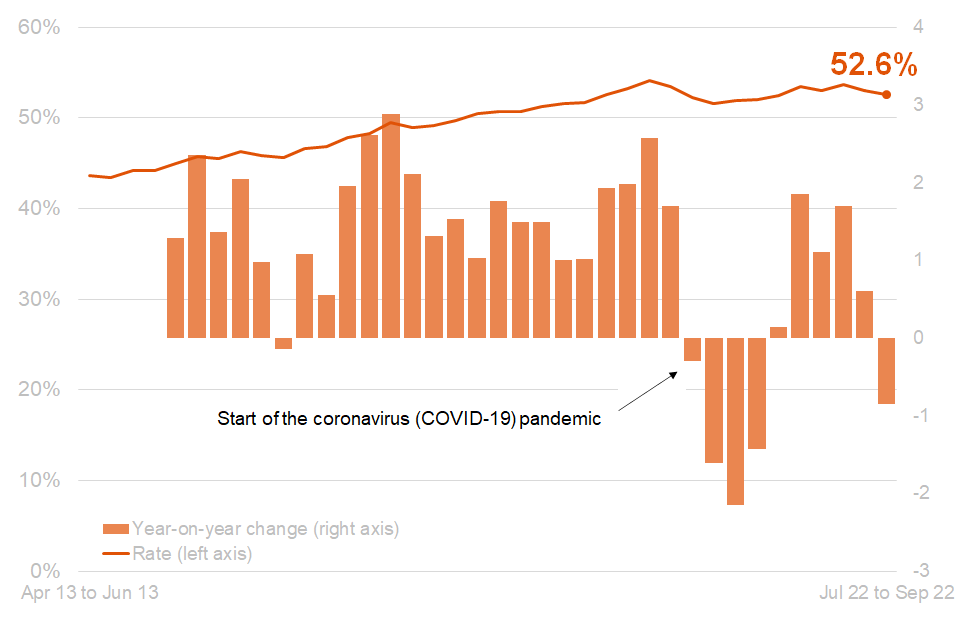
Source: Labour Force Survey – data and definitions can be found in supplementary data table MSR001
The disability employment rate has increased by 9.2 percentage points from 43.4% in July to September 2013 to 52.6% in July to September 2022. The rate began to fall (year-on-year) at the start of the coronavirus (COVID-19) pandemic before showing signs of recovery. The latest quarter (July to September 2022) showed the rate fall by 0.8 percentage points (compared to the same quarter last year) meaning the rate is now below where it was in 2019.
The disability employment gap is now at its widest point since 2018
Figure 3: Disability employment gap (percentage point), people aged 16 to 64, UK, April to June 2013 to July to September 2022

Source: Labour Force Survey – data and definitions can be found in supplementary data table MSR001
The disability employment gap has decreased by 4.4 percentage points from 34.2 percentage points in July to September 2013 to 29.8 percentage points in July to September 2022. The gap started to widen (year-on-year) at the start of the coronavirus (COVID-19) pandemic which was the first time this had happened across more than one quarter in eight years.
There were some signs of improvement, but the latest quarter (July to September 2022) showed the gap widen by 1.7 percentage points (compared to the same quarter last year). This was driven, almost equally, by a fall in the disability employment rate (0.8 percentage points) and a rise in the non-disabled employment rate (0.9 percentage points points).
The increasing number of disabled people in employment is associated with four main components of change
There are four components of change in the number of disabled people in employment:
-
overall working-age population
-
disability prevalence
-
non-disabled employment rate
-
disability employment gap
Each of these factors has contributed to the increased number of disabled people in employment since July to September 2013. However, it is not possible to directly measure the impact of each component because they interact with each other.
Instead, an indirect measure of each component can be modelled using a hypothetical scenario. We assume that only the component being measured followed the path observed in the actual data between July to September 2013 and the same quarter in 2022, while the other components remain fixed at the levels observed in July to September 2013.
A similar approach can be used to estimate the interactions between components. For example, the combined impact of increases in both disability prevalence and in non-disabled employment is greater than the sum of the impact of prevalence alone and the impact of non-disabled employment alone. That difference gives us an estimate of the ‘interaction’ effect between these two components of change. See background information and methodology for more details on how these estimates are derived.
These estimates are intended to give a broad indication of the impact of the different components. They tell us about the components of change, but not the causes. Neither do they capture all interactions. For example, an increase in disability prevalence could impact the disability employment gap, even without any changes in employment, if prevalence increased faster among those already in work than among those out of work.
Figure 4: Number of disabled people in employment by component of change, people aged 16 to 64 years, UK, Jul-Sep 2013 to Jul-Sep 2022
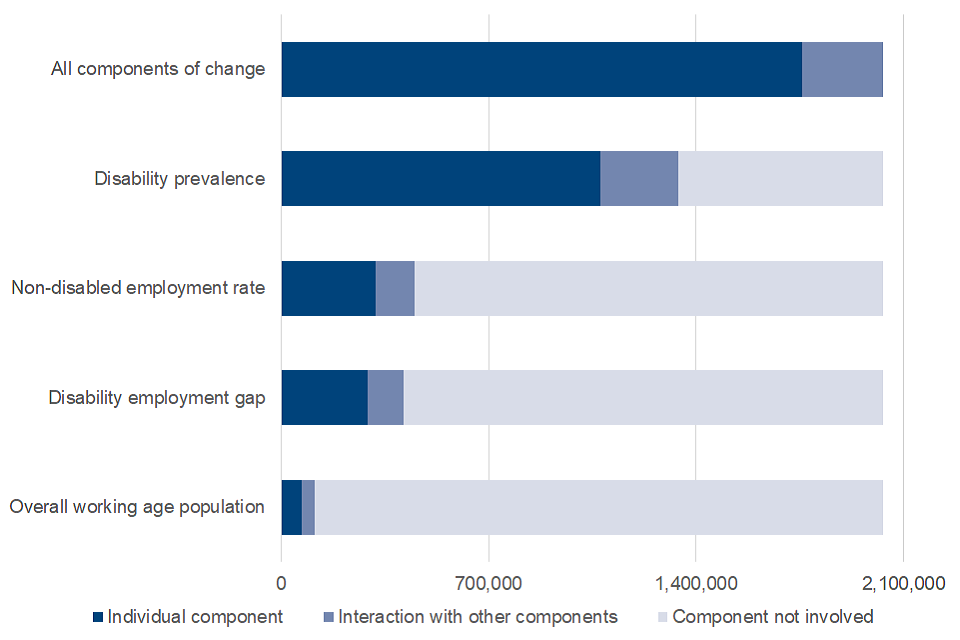
Source: Labour Force Survey – data and definitions can be found in supplementary data table MSR002
Over the past nine years, between July to September 2013 and the same quarter in 2022, the number of disabled people in employment has increased by 2.0m from 2.9m to 4.9m.
Figure 4 shows how much of this increase may be attributed to the four components of change. For each component, a range is given. The lower end of the range shows the estimated impact of that component in isolation (dark blue bar); the upper end gives the impact including all interaction effects with the other components (mid-blue bar) and the light blue shaded area is any increase where the component is not involved. Therefore, the same interaction effects can appear in the chart under more than one component. However, taken as a whole, these interactions had a relatively small impact.
The impact of each component on the increase in the number of disabled people in employment is estimated as:
-
60% for disability prevalence (1,080,000 to 1,340,000)
-
20% for non-disabled employment rate (320,000 to 450,000)
-
15% for disability employment gap (290,000 to 410,000)
-
5% for working age population (70,000 to 110,000)
The increase in disability prevalence is associated with an increase in people reporting mental health conditions. This is covered in more detail in the next section.
5. Populations
The next section looks at how the working-age population has changed over the last nine years. In particular, the changes in the number of people who report having a long-term health condition or are classed as disabled and how these are associated with different demographics.
A person is classed as:
-
having a long-term health condition if they answer ‘Yes’ to question 1 (see below)
-
disabled if they answer ‘Yes’ to question 1 and either ‘Yes, a little’ or ‘Yes, a lot’ to question 2
-
disabled, limited a lot if they answer ‘Yes’ to question 1 and ‘Yes, a lot’ to question 2
| Questions | Response options |
|---|---|
| 1. Do you have any physical or mental health conditions or illnesses lasting or expected to last 12 months or more? | Yes or no |
| 2. Does your condition or illness reduce your ability to carry-out day-to-day activities? | Yes, a little; Yes, a lot or No |
Over one in five of the working-age population are classed as disabled
Figure 5: Proportion of the population with a long-term health condition, classed as disabled, including those limited a lot, people aged 16 to 64 years, UK, 2021/2022

Source: Annual Population Survey – data and definitions can be found in supplementary data table POP001
The number of people reporting a long-term health condition or classed as disabled continues to rise
Figure 6: Number of people with a long-term health condition, classed as disabled, including those limited a lot, people aged 16 to 64, UK, 2013/14 to 2020/21

Source: Annual Population Survey – data and definitions can be found in supplementary data table POP001
The working-age population in the UK has increased by 850,000 (2.1%) in last nine years from 40.6m (2013/2014) to 41.4m (2021/2022). The rate of increase has slowed in the recent years, increasing by an average of 0.1% a year between 2020/2021 and 2021/2022 compared to an average of 0.4% a year between 2013/2014 and 2014/2015.
Between 2013/2014 and 2021/2022, the number of people reporting a long-term health condition increased by 2.6m (22.4%). Of those with a long-term health condition, the number of people who reported their condition limited their day-to-day activities (classifying them as disabled) increased by 2.1m (30.7%). Of those, the number who reported their day-to-day activities were limited a lot increased by 850,000 (29.8%). To put this into context the increase in number (850,000) is the same as for the working-age population as whole during the same period.
The number and rate of people reporting a long-term health condition or classified as disabled (including those whose day-to-day activities were limited a lot) is increasing faster now than in each of the last nine years. 2021/2022 saw the largest annual increase in number of people reporting a long-term health condition 610,000 (4.4%), classified as disabled 730,000 (8.8%) and disabled, limited a lot 410,000 (12.3%).
The longer-term increase in the number of disabled people could be due to several factors, including changes in public awareness and attitudes towards disability. However, we have seen in other functional based surveys which do not rely on people self-reporting disability that these are not the only factors. For example, the Adult Psychiatric Morbidity Survey shows increases in prevalence for some conditions which may be due to changes in society and health, including behaviours associated with diet and levels of physical activity.
The rising number of people classed as disabled is associated with an increase in people reporting mental health conditions
Figure 7: Change in the number of disabled people by age, gender and main health condition (MSK and MH only), people aged 16 to 64, UK, 2013/2014 to 2021/2022
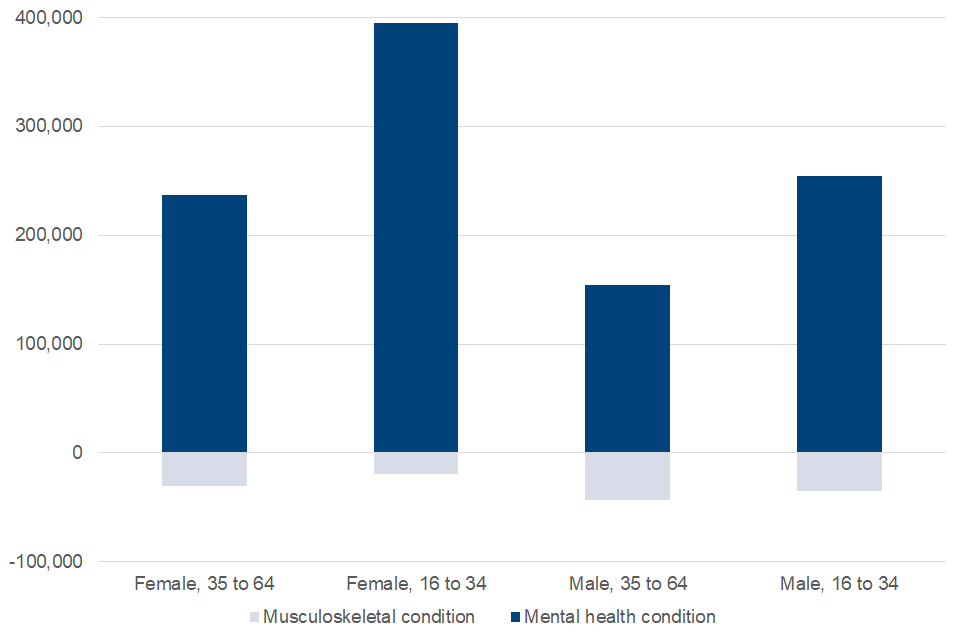
Source: Annual Population Survey – data and definitions can be found in supplementary data table POP001
Musculoskeletal (MSK) conditions include problems or disabilities connected with the arms, hands, legs, feet, back or neck. Mental health (MH) conditions include depression, bad nerves, anxiety, mental illness or other nervous disorders.
Data for all health conditions is provided in the supplementary tables should alternative breakdowns be required.
The number of disabled people with a mental health condition as their main condition has increased by 1.0m (83.7%) between 2013/14 and 2021/22. This compares to musculoskeletal conditions which have shown a decrease of 130,000 (5.4%) in the same period. However, there are still 2.3m disabled people (25.1%) whose main heath condition is musculoskeletal. There are also 1.5m disabled people (16.1%) who report having both a mental health and a musculoskeletal condition.
The increase in the number of people being classed as disabled has been greater for:
-
women, 1.3m (35.0%), compared to men, 790,000 (25.4%)
-
younger people (aged 16 to 34), 1.1m (63.7%) compared to older people (aged 35 to 64), 1.0m (20.0%)
The largest increase across age, gender and health condition was for women aged 16 to 34 with a mental health condition (as their main condition) who saw an increase of 390,000 (152.7%).
Some long-term health conditions are associated with a greater impact on a person’s day-to-day activities
Figure 8: Proportion of people with a long-term health condition, classed as disabled, including those limited a lot, by main health condition, people aged 16 to 64 years, UK, 2021/2022
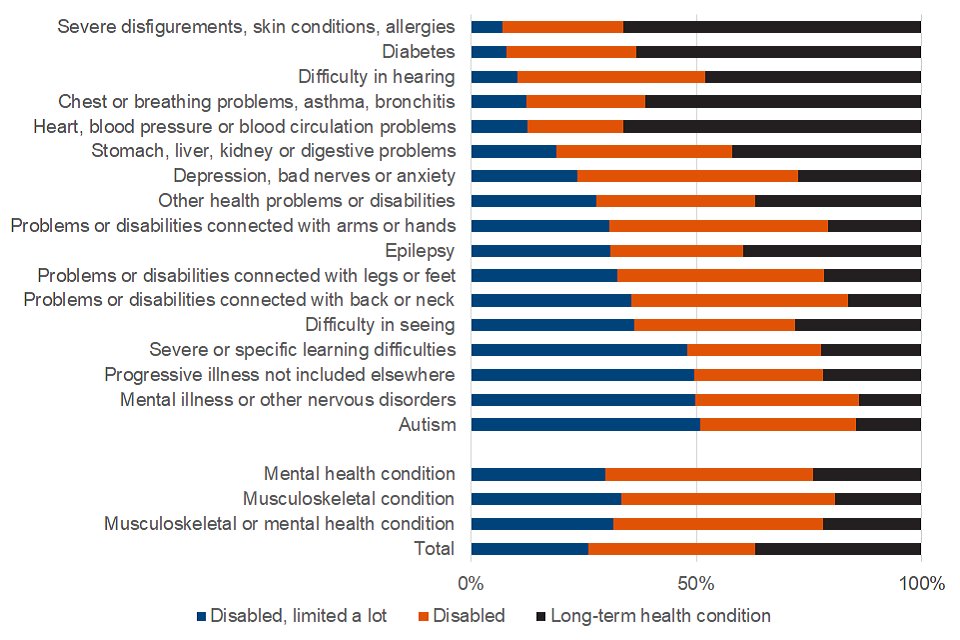
Source: Annual Population Survey – data and definitions can be found in supplementary data table POP003
There are large differences on the impact a persons’ main long-term health condition has on their day-to-day activities. For example, 6.9% of those who reported severe disfigurements, skin conditions, allergies as their main condition said it affected their day-to-day activities a lot. In comparison, 50.9% of people with autism and 49.4% of those with a progressive illness (not included elsewhere) said it affected their day-to-day activities a lot.
People with a mental health condition as their main long-term health condition were less likely to report that it limited their day-to-day activities a lot compared to people with a musculoskeletal condition (29.9% compared to 33.3%). However, there is a large difference between the different groupings that make up the mental health condition figure. Of the people who reported depression, bad nerves, or anxiety 23.6% said their condition limited their day-to-day activities a lot. This compares to people with a mental illness or other nervous disorder where around twice this figure (49.7%) said their day-to-day activities were limited a lot. This group makes up 23.9% of all those who report a mental health condition as their main condition.
Estimates for some long-term health conditions are based on small sample sizes and therefore subject to a higher degree of uncertainty. Sample sizes for all long-term health conditions can be found in supplementary data table POP003U. The equivalent data for main or secondary long-term health conditions can be found in supplementary data table POP004 and supplementary data table POP004U.
6. Labour market status
The next section looks at the labour market status of individuals, specifically whether they are in employment or not. Employment is defined as anyone who has done one or more hour of paid work and those who have a job that they are temporarily away from (for example, because they are on holiday or off sick).
The largest two categories within employment are employees and self-employed people; in recent years these two categories have accounted for over 99% of all people in employment. People who are not in employment will be either unemployed or economically inactive.
These breakdowns are shown for different characteristics, by disability status and over time.
The disability employment gap increases with age
Figure 9: Proportion of people in employment by disability status and age, people aged 16 to 64 years, UK, 2021/2022
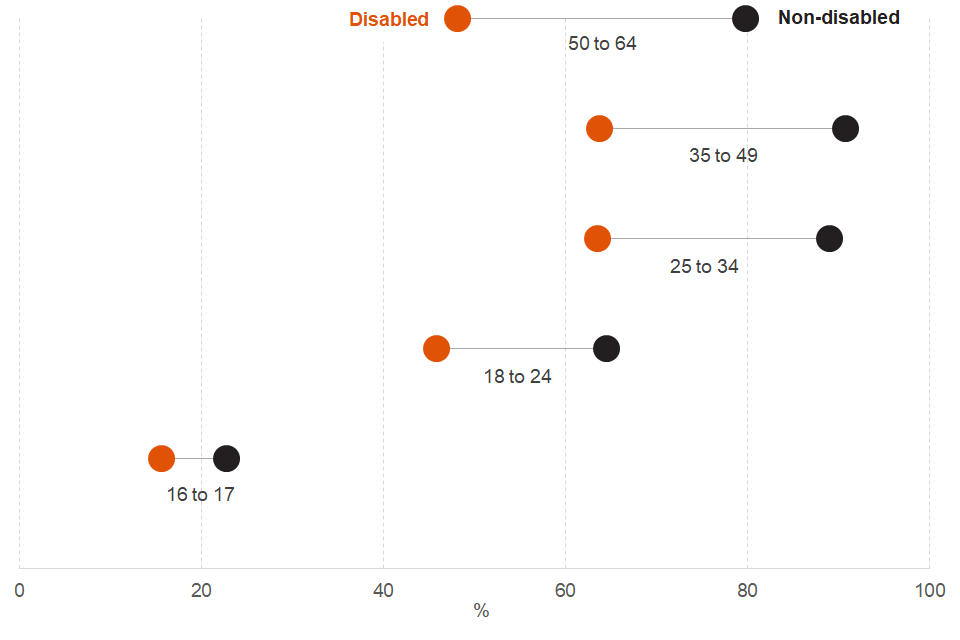
Source: Annual Population Survey – data and definitions can be found in supplementary data table LMS001
Employment rates for disabled people, across all ages, are lower than those of non-disabled people. For both disabled and non-disabled people, employment rates generally increase with age up to the age of 50 where they start to decrease. 16 to 17-year-olds have the lowest employment rates but this is because they are more likely to be in education or training than in employment.
The disability employment gap increases with age with those aged 50 to 64-years-old having the largest gap (31.7 percentage points compared to 18.7 percentage points for 18 to 24-year-olds). The 50 to 64-year-old age group makes up over 40% of the working-age disabled population, whilst the 18 to 24-year-old age group makes up just over 10% of the working-age disabled population.
Disabled women are now as likely to be in employment as disabled men
Figure 10: Proportion of people in employment by gender, disabled people aged 16 to 64 years, UK, 2013/2014 to 2021/2022
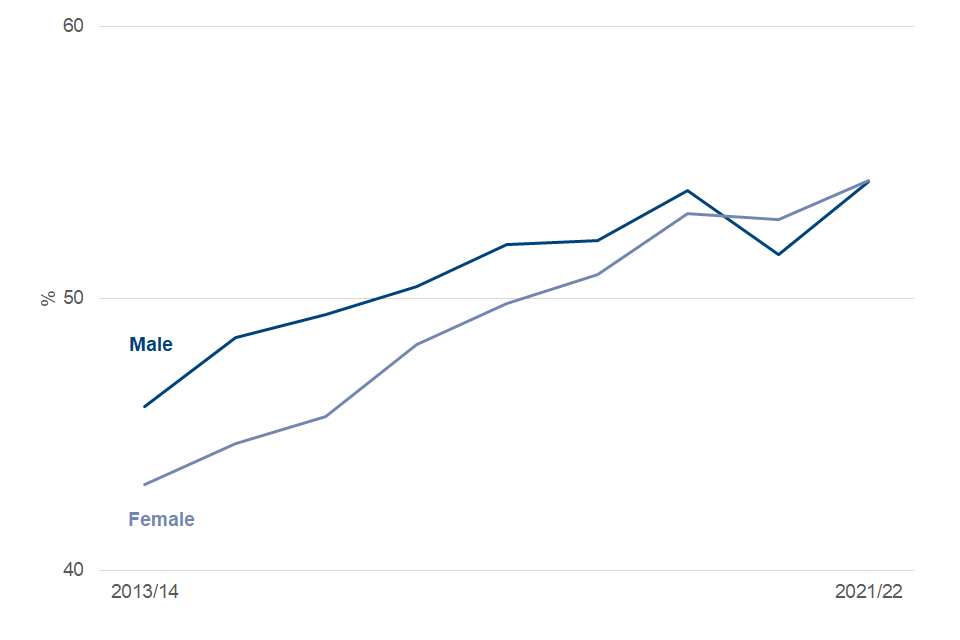
Source: Annual Population Survey – data and definitions can be found in supplementary data table LMS002
The gap between the employment rates of disabled women and men has been closing for several years with the rate for both in 2021/22 now estimated at 54.3%. The employment rate for disabled women has increased by 11.2 percentage points from 43.1% in 2013/2014 with the rate for men increasing more slowly - by 8.3 percentage points from 46.0% in 2013/2014.
This contrasts with non-disabled people where, in 2021/2022, women had an employment rate of 77.5% compared to 84.5% for men, a difference of 7.0 percentage points. This means that the disability employment gap is narrower for women (23.1 percentage points compared to 30.2 percentage points for men). The gap has closed for both women and men over the past nine years at a similar rate (5.7 percentage points for women and 6.0 percentage points for men).
Disabled people with a musculoskeletal condition are more likely than those with a mental health condition to be in employment
Figure 11: Proportion of people in employment by main or secondary health condition, people aged 16 to 64 years, UK, 2021/2022
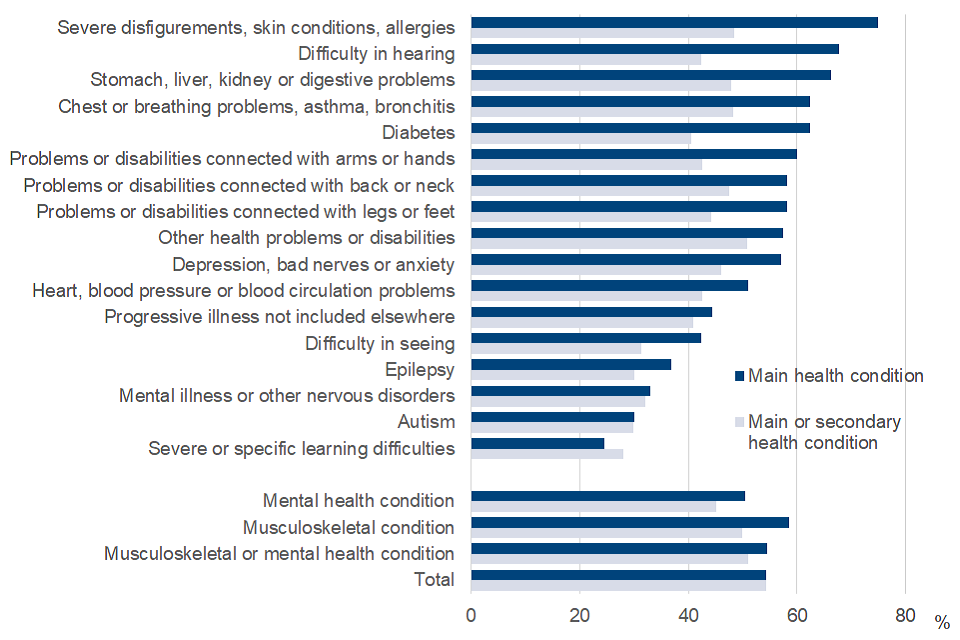
Source: Annual Population Survey – data and definitions can be found in supplementary data tables LMS003 and LMS004
Musculoskeletal (MSK) conditions include problems or disabilities connected with the arms, hands, legs, feet, back or neck. Mental health (MH) conditions include depression, bad nerves, anxiety, mental illness or other nervous disorders.
Data for all health conditions is provided in the supplementary tables should alternative breakdowns be required.
There is a lot of variation in employment rates of disabled people for different health conditions. For example, people whose main health condition is Severe disfigurements, skin conditions, allergies are three times more likely to be in employment compared to someone whose main health condition is Severe or specific learning difficulties (74.8% compared to 24.5%). Disabled people with a musculoskeletal condition are more likely than those with a mental health condition to be in employment (58.6% compared to 50.5% in 2021/2022 where it is the main condition). However, 1.5m (or 16.1% of disabled people) report having both a musculoskeletal and a mental health condition.
The difference in employment rates for different conditions may be associated with the effect the condition has on a person’s day-to-day activities. For example, 6.9% of people with Severe disfigurements, skin conditions, allergies reported their main condition affected their day-to-day activities “a lot” compared to 48.0% for Severe or specific learning difficulties (see supplementary data table POP003).
Employment rates for health conditions where the condition is secondary are generally lower than those for main conditions. This is because people with a secondary condition will, by definition, have more than one health condition. We know that the more health conditions a person has the less likely they are to be in employment (see supplementary data table LMS005).
Disabled people with one health condition are more than twice as likely to be in employment than those with five or more conditions
Figure 12: Proportion of people in employment by number of health conditions, people aged 16 to 64 years, UK, 2021 to 2022
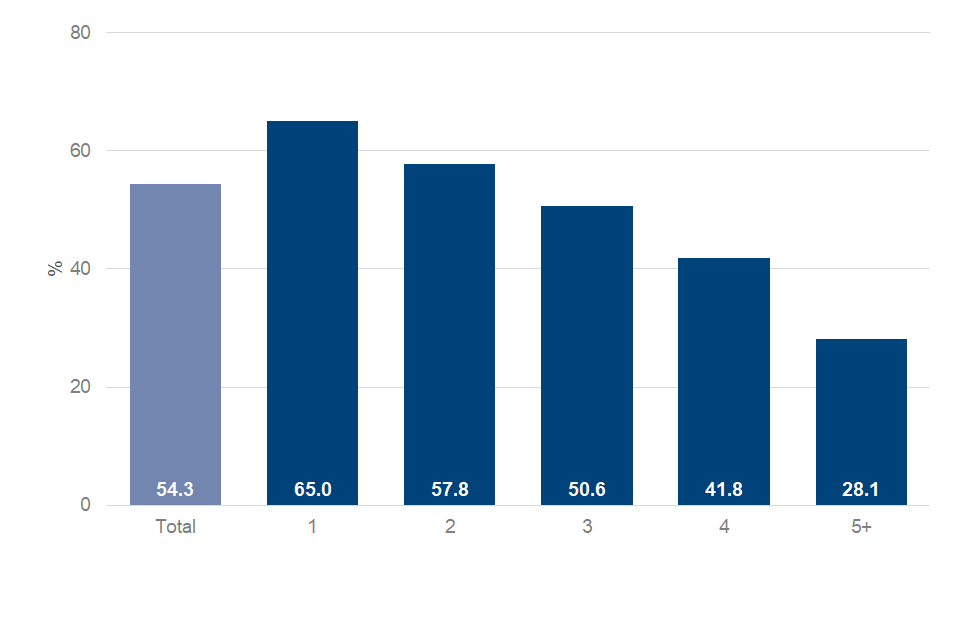
Source: Annual Population Survey – data and definitions can be found in supplementary data table LMS005
The proportion of disabled people reporting more than one long-term health condition was generally falling prior to the coronavirus (COVID-19) pandemic - from 60.7% in 2013/2014 to 55.9% in 2019/2020. In 2020/2021 the proportion increased to 60.4% before falling again in 2021/2022 to 57.5%, which is still above the pre-pandemic figure.
65.0% of disabled people with one health condition were in employment in 2021/2022. This proportion continues to increase (from 57.4% in 2013/2014) and is 10.7 percentage points higher than the rate for all disabled people. Employment rates decline as the number of health conditions increases. Less than a third of disabled people with five or more health conditions were in employment in 2021/2022.
Disabled people of White ethnicity have the largest disability employment gap
Figure 13: Proportion of people in employment by disability status and ethnicity, people aged 16 to 64 years, UK, 2021 to 2022
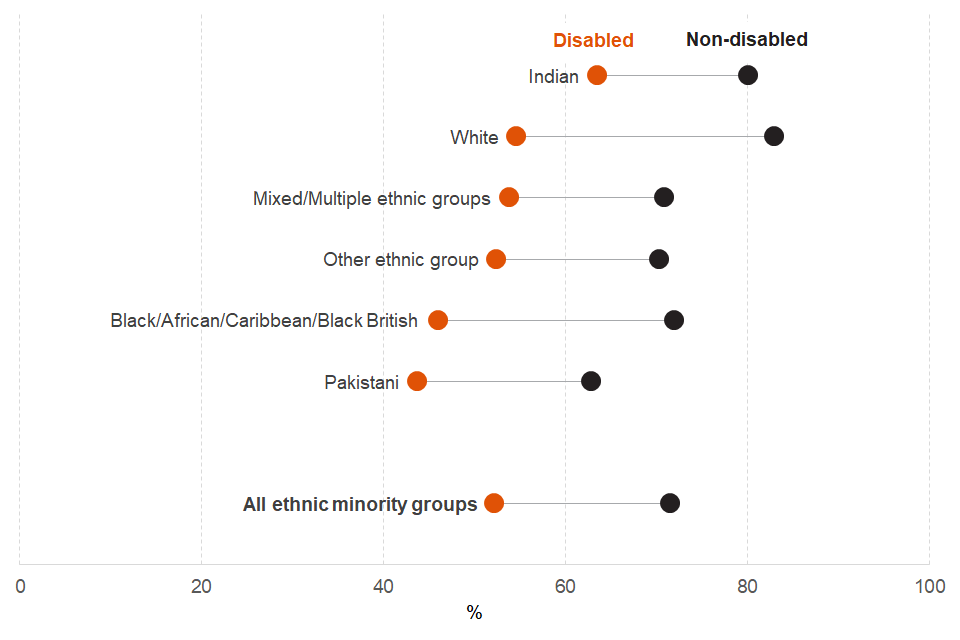
Source: Annual Population Survey – data and definitions can be found in supplementary data table LMS007
Disabled people of all ethnicities are less likely to be in employment compared to their non-disabled counterparts. People of Indian ethnicity have the highest disability employment rate (63.5%) whilst people of Pakistani ethnicity one of the lowest (43.8%).
Disabled people of White ethnicity have the largest disability employment gap (28.3 percentage points). This is due in part to them also having the highest non-disabled employment rate (82.9%). The disability employment gap for all ethnic minority (non-White) groups is 19.4 percentage points.
Estimates for Bangladeshi, Chinese and any other Asian background ethnic groups are based on small sample sizes and subject to a higher degree of uncertainty and are therefore not included in this analysis. The data for all groups can be found in supplementary data table LMS007.
Despite falling across most areas of the UK there are still large differences in the disability employment gap in different parts of the country
Figure 14: Disability employment gap (percentage points) by country and region, people aged 16 to 64 years, UK, 2013/2014 to 2021/2022
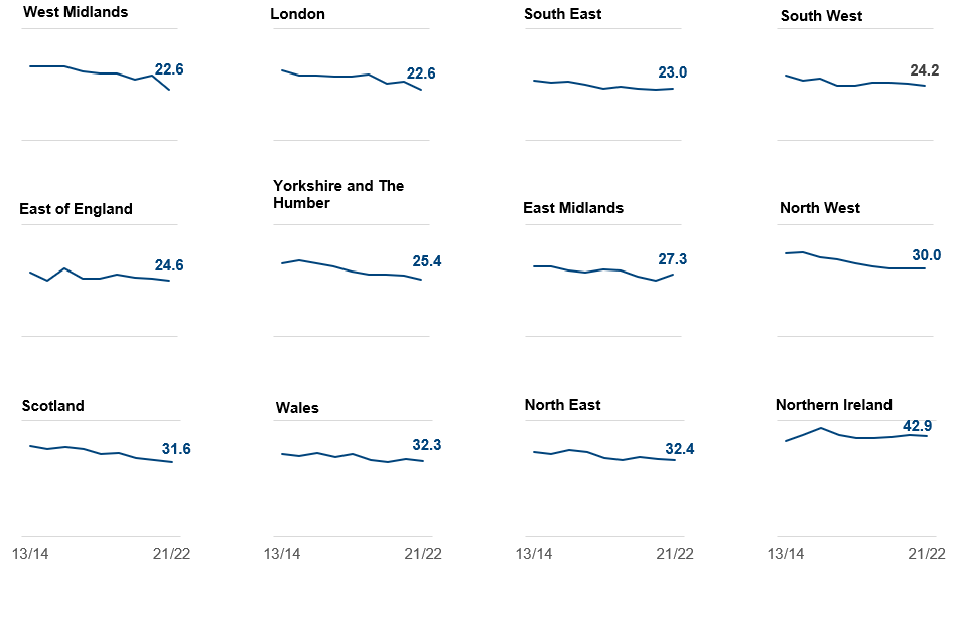
Source: Annual Population Survey – data and definitions can be found in supplementary data table LMS008
All areas of the UK have seen a reduction in the disability employment gap between 2013/2014 and 2021/2022 except Northern Ireland where the gap has remained stable.
The areas that ranked above the UK average in 2013/2014 were Northern Ireland, Scotland, North West, North East, Wales and West Midlands. Yorkshire and The Humber, East Midlands, London, South West, East of England and South East ranked below. The only change to this list, in 2021/2022, was West Midlands who are now below the UK average and East Midlands who are now above.
West Midlands (6.1 percentage points) and London (3.6 percentage points) are the two areas that have seen the largest reductions in the disability employment gap in the past 12 months.
Local authorities with the largest disability employment gaps tend to be concentrated within certain areas of the country
Figure 15: Disability employment gap (percentage points) by Local Authority, people aged 16 to 64 years, Great Britain, 2018 to 2020
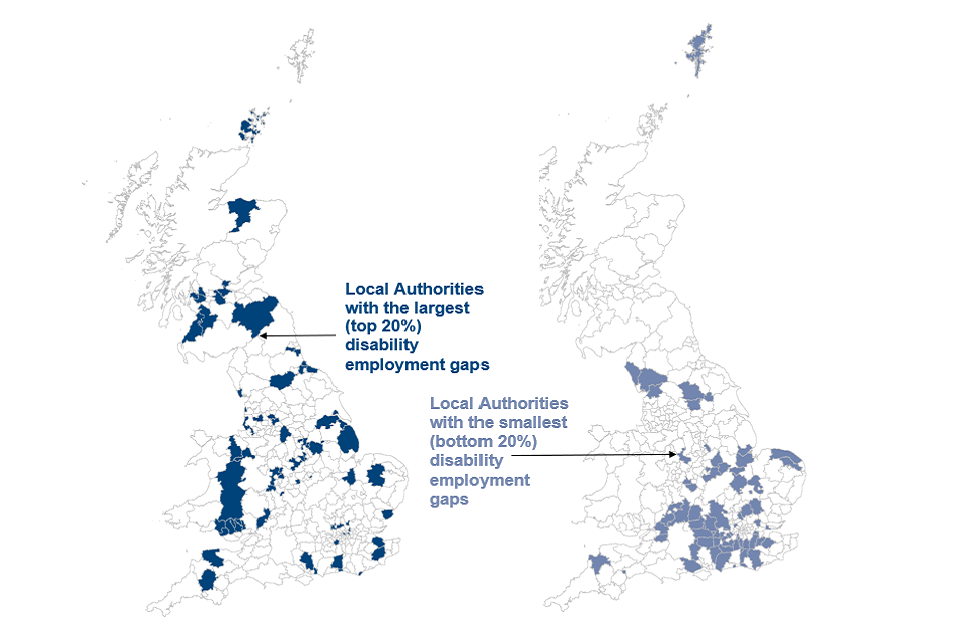
Source: Annual Population Survey – data and definitions can be found in supplementary data table LMS009
Local Authorities with the largest disability employment gaps can be found across most regions and countries of the UK. However, many of these are concentrated in Scotland, Wales, and the North East of England. For example, Local Authorities with the largest (top 20%) disability employment gaps include Inverclyde and West Dunbartonshire in Scotland (44.0 and 43.2 percentage points), Blaenau Gwent and North Port Talbot in Wales (46.8 and 44.5 percentage points) and Redcar and Cleveland in the North East of England (44.5 percentage points).
In contrast, Local Authorities with the smallest disability employment gaps tend to be found in the South and East of Great Britain. Local Authorities with the lowest disability employment gap (bottom 20%) include New Forest (3.4 percentage points), Brighton and Hove (9.6 percentage points) and Wealden (13.4 percentage points) all in the South East of England.
Data for Northern Ireland is not available below country level and is therefore not shown in the Local Authority map above (Figure 15). Data for all Local Authorities, regions and countries of the UK, including Northern Ireland, can be found in supplementary data table LMS009. The equivalent data for Parliamentary Constituencies can be found in supplementary data table LMS010.
7. Employment
The next section looks at differences between disabled and non-disabled people who are in employment.
Disabled workers are more likely to work in the Health, Retail and Education industries
Figure 16: Percentage of people employed in each industry by disability status, people aged 16 to 64 years, UK, 2021/2022
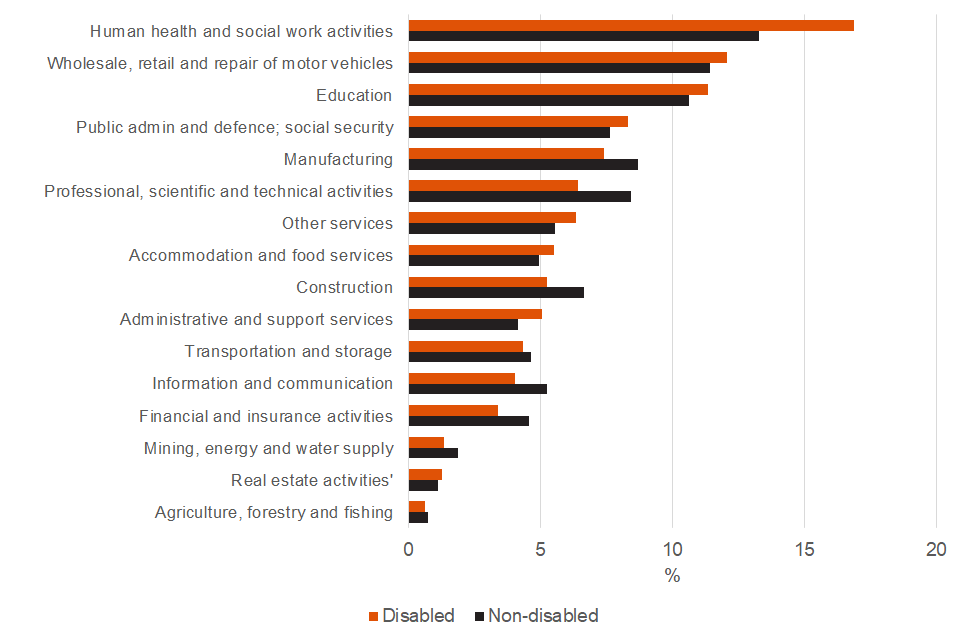
Source: Annual Population Survey – data and definitions can be found in supplementary data table EMP001
In 2021/2022 both disabled and non-disabled workers (including those who are self-employed) were most likely to be working in the following industries:
-
Human health and social work activities
-
Wholesale, retail and repair of motor vehicles
-
Education
These three industries made up 40.3% of disabled people in employment and 35.3% of non-disabled people in employment. Disabled people are more likely than non-disabled people to be working in these three industries.
The industries, in 2021/2022, where disabled workers were most likely to be under-represented, compared to non-disabled workers, are:
-
Professional, scientific and technical activities (6.4% of disabled workers compared to 8.4% of non-disabled workers)
-
Construction (5.2% compared to 6.7%)
-
Manufacturing (7.4% compared to 8.7%)
-
Information and communication (4.0% compared to 5.3%)
-
Financial and insurance activities (3.4% compared to 4.6%)
Disabled workers are less likely to be in higher-skilled occupations
Figure 17: Proportion of people in employed in each occupation by disability status, people aged 16 to 64 years, UK, 2021/2022

Source: Annual Population Survey – data and definitions can be found in supplementary data table EMP002
Both disabled and non-disabled workers were more likely to be working in Professional occupations and less likely to be working as Process, plant and machine operatives in 2021/2022.
Disabled workers were less likely to be in higher skilled occupations such as, Managers, directors and senior officials; Professional occupations; Associate professional and technical occupations, than non-disabled workers. However, the proportion of disabled workers in these occupations has increased over the past nine years, from 37.5% in 2013/2014 to 43.8% in 2021/2022.
Disabled workers were also more likely to be working in Caring, leisure and other service occupations; Elementary occupations; Administrative and secretarial occupations and Administrative and secretarial occupations than non-disabled workers. Conversely, the proportion of disabled workers in these occupations has decreased over the past nine years, from 44.8% in 2013/2014 to 42.3% in 2021/2022.
Disabled workers are more likely than non-disabled workers to be self-employed
Figure 18: Proportion of people in employment who are self-employed by disability status, employed people aged 16 to 64 years, UK, 2013/2014 to 2021/2022

Source: Annual Population Survey – data and definitions can be found in supplementary data table EMP003
The proportion of disabled workers who are self-employed has decreased by 2.1 percentage points from 15.7% in 2013/2014 to 13.6% in 2021/2022. This compares to non-disabled workers where the proportion has fallen by 1.4 percentage points from 13.5% to 12.1% over the same period.
The difference between the proportion of disabled and non-disabled workers who are self-employed decreased to a seven-year low (0.8 percentage points) in 2019/2020. However, in the past year, the difference has increased to 1.5 percentage points. This has been driven by a decrease in the proportion of non-disabled workers who are self-employed (by 0.6 percentage points), while the proportion of disabled workers has stayed the same.
Falls in self-employment during the coronavirus (COVID-19) pandemic, for disabled and non-disabled workers, may in part be explained by a shift in people reclassifying themselves from self-employed to employees. This coincides with the introduction of the furlough scheme. The following article covers this in more depth: Understanding changes in self-employment in the UK - Office for National Statistics (ons.gov.uk).
One in three disabled workers are working part-time
Figure 19: Percentage of people in employment by disability status and working pattern, people aged 16 to 64 years, UK, 2021/2022
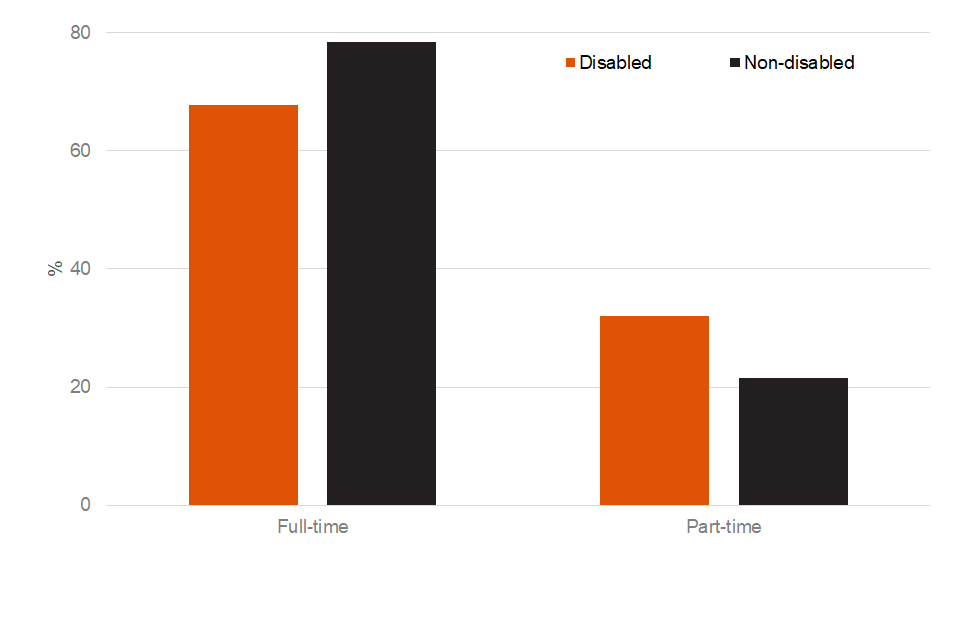
Source: Annual Population Survey – data and definitions can be found in supplementary data table EMP004
Disabled workers are more likely to be working part time, with 32.0% of disabled workers and 21.5% of non-disabled workers working part-time. Between 2013/2014 and 2021/2022 these proportions have decreased for both disabled and non-disabled workers. However, the proportion of workers working part-time has decreased more slowly (by 1.8 percentage points) for disabled workers than for non-disabled workers (by 3.1 percentage points).
Disabled workers are more likely to be employed in the public sector
Figure 20: Proportion of people in employment by disability status and sector, employed people aged 16 to 64, UK, 2021/2022

Source: Annual Population Survey – data and definitions can be found in supplementary data table EMP005
Disabled workers are less likely to be working in the private sector than non-disabled workers and consequently more likely to be working in the public sector. For both disabled and non-disabled workers around three times as many people work in the private sector compared to the public sector.
These patterns are related to the industries people work in (see supplementary data table EMP005). For example, disabled people are more likely to work in Human health and social work activities, Education and Public admin and defence; social security which are predominately public sector industries.
The proportion of disabled people working in the public sector remained relatively stable between 2014/2015 and 2019/2020 – 23.1% to 23.7%. In 2020/2021 – the first year of the coronavirus (COVID-19) pandemic – the proportion increased to 26.5%. In 2021/2022 the proportion was 25.8%, which is 2.0 percentage points above that seen prior to the pandemic.
Disabled employees are more likely to be working for small employers and less likely to working for a large employer
Figure 21: Proportion of people in employment by disability status and employer size, employees aged 16 to 64, UK, 2021/2022

Source: Annual Population Survey – data and definitions can be found in supplementary data table EMP006
Disabled employees (excluding people who are self-employed) are more likely, than non-disabled employees, to be working for small employers and less likely to working for a large employer. They are equally likely to be working for a medium sized employer.
There has been a shift since 2014/2015 with both disabled and non-disabled employees more likely to work for large employers and less likely to work for a small employer. Small employers however still make up the largest group – 43.6% of all employees in 2021/2022.
8. Economic inactivity
The next section looks at differences between disabled and non-disabled people who are in economic inactivity.
The number and percentage of economically inactive people classed are disabled has been rising since 2018/2019 – after falling for three years in a row. The number increased by 0.3m between 2018/2019 and 2021/2022 from 3.4m to 3.7m. The percentage increased by 3.0 percentage points from 38.7% to 41.7% over the same period. This coincides with an increase in the number and percentage of working age people who state the main reason for being economically inactive is long-term sickness. The following article covers this in more depth: Half a million more people are out of the labour force because of long-term sickness - Office for National Statistics (ons.gov.uk).
Nearly three in every five economically inactive disabled people give long-term sickness as the main reason for being inactive
Figure 22: Proportion of economically people by main reason and disability status, people aged 16 to 64, UK, 2021/2022

Source: Annual Population Survey – data and definitions can be found in supplementary data table EIA001
Long-term sickness is the main reason given by disabled people for being economically inactive (57.5% in 2021/2022). This has remained stable over the last nine years (57.4% in 2013/2014). The next three largest reasons given in 2021/2022 were looking after family / home (14.0%), being a student (9.7%) and retirement (7.8%). Economically inactive non-disabled people were more likely to state their main reason for being inactive as being a student (40.9%), looking after family / home (23.7%) and retirement (17.8%), with only 1.6% stating long-term sickness.
Conversely, 95.7% of people who gave long-term sickness as their main reason for being economically inactive in 2021/2022 were disabled. This has remained stable at around 96% over the past nine years. This compares to looking after family / home (30.0% were disabled) and being a student (14.6% were disabled), which have increased by 8.9 and 5.7 percentage points respectively, and retirement which has decreased by 4.6 percentage points (24.1% were disabled). For all economically inactive people the increase in the percentage classed as disabled between 2013/2014 and 2021/2022 was 5.6 percentage points.
Economically inactive people are more likely to want a job if they are disabled
Figure 23: Proportion of economically inactive people who want a job by disability status, economically inactive people aged 16 to 64, UK, 2013/2014 to 202120/22
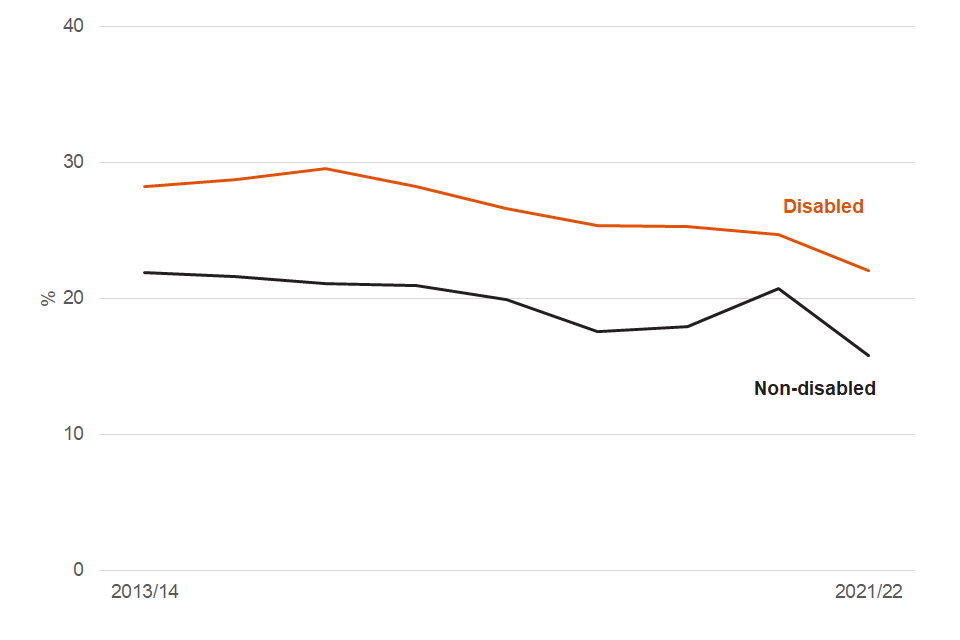
Source: Annual Population Survey – data and definitions can be found in supplementary data table EIA002
The proportion of economically inactive disabled people who wanted a job in 2021/2022 was 22.0%. This compares to non-disabled people where the equivalent figure was 15.7%. This may be explained by the reasons disabled and non-people are more likely to give for being inactive (see Figure 22). Disabled people are less likely to be a student or retired but these groups make up nearly half of all those say they do not want a job (see supplementary data table supplementary data table EIA004).
The proportions have generally fallen, for both disabled and non-disabled people, over the past nine years but the difference between the two is the same in 2021/2022 (6.3 percentage points) as it was in 2013/2014. The fall in the proportion of economically inactive people who want a job was greater in 2021/2022 than any other year since at least 2013/2014. This was 2.7 percentage points for disabled people and 5.0 percentage points for non-disabled people (this after rising during the first year of the coronavirus (COVID-19) pandemic).
Economically inactive disabled people are less likely to have had a job in the last two years
Figure 24: Proportion of economically people by when left last job, age and disability status, people aged 16 to 64, UK, 2021/2022

Source: Annual Population Survey – data and definitions can be found in supplementary data table EIA003
In 2021/2022, 59.3% of economically inactive disabled people had not had a job in the last two years compared to 33.5% of non-disabled people.
Economically inactive disabled people are less likely to have never had a paid job (25.0% compared to 44.1% for non-disabled people). However, they were less likely to be younger (29.3% are aged 16 to 34 compared to 53.4% of non-disabled people) and were less likely to give the main reason for being inactive as being a student (see Figure 22). This means that non-disabled people were more likely to still be in full-time education and may not yet have entered the labour market. This may partly explain why they are more likely to have never had a paid job.
For economically inactive people aged 16 to 34, disabled people were more likely to have not had a job in the last two years (23.8% v 9.3%) but less likely to have never had a paid job (61.9% v 75.6%) - compared to non-disabled people. For the 35-to 64-year-old age group, disabled people were again more were more likely to have not had a job in the last two years (75.5.9% v 62.0%) and less likely to have had a job in the last two years (14.2% v 28.8%). Around one in ten of both disabled and non-disabled people aged 35 to 64 who are economically inactive have never had paid job.
Most economically inactive disabled people give long-term sickness as their main reason for being inactive. Data specifically for this group can be found in supplementary data tables EIA012 to EIA021.
9. Flows
The next section focuses mainly on the movements, or flows, between employment status (in or not in work) from one year to the next.
Employment status is - measured a year apart so will not include movements within the year. For example, a person may be in employment when they complete the survey in the first year, move out of employment (and then back in) and be in employment when they are surveyed the following year. In this scenario the person would be classed as having remained in employment.
Estimates are averaged over more than one year to increase precision.
People not in work will be either unemployed or economically inactive.
In general, disabled people are more likely to move out of work and less likely to move into work, compared to non-disabled people, over the course of a year.
-
On average, between 2014 and 2019, around 340,000 disabled workers moved out of work each year and 380,000 workless disabled people moved into work (includes people who were classed as disabled at the start of the year)
-
This trend has been reversed in the last two years (2020 and 2021) with, on average, more disabled workers moving out of work (420,000) than moving in (350,000)
-
On average, between 2014 and 2021, disabled workers moved out of work at nearly twice the rate (8.9%) of non-disabled workers (5.1%). Workless disabled people moved into work at nearly one-third of the rate (9.7%) of workless non-disabled people (26.8%)
Nearly one in three people classed as being disabled one year were no longer classed as being disabled the next
Figure 25: Flows between disability and employment status, people aged 16 to 64 years, UK, 2014 to 2021
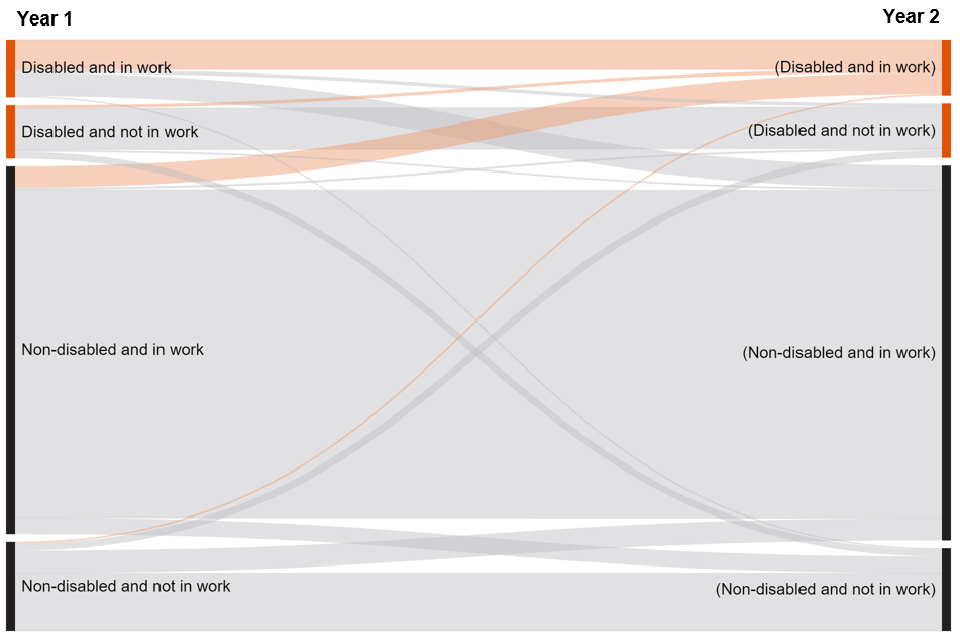
Source: Annual Population Survey – data and definitions can be found in supplementary data table FLW001
Figure 25 shows how people move between the different disability and employment states from one year to the next. This is taken as an average between 2014 and 2021 with the thickness of the line representing the number of people. By far the biggest group is non-disabled people who are in work one year, and still in work and classed as non-disabled the next.
Nearly one in three people classed as being disabled one year were no longer classed as being disabled the next. This suggests that disability is not static and that it can change. For disabled people in work one year, 91.2% are still in work the following year. Of these, 43.4% are no longer classed as being disabled. This compares to 14.1% for disabled people who are still out of work the following year which suggests that people are more likely to change their status from disabled to non-disabled if they are in work.
The orange lines in Figure 25 show the disability and employment status in year one of all the disabled people who were in work in year two. 59.1% of them are disabled people who have remained in work (53.2%) or moved into work (5.9%). The other 40.9% are non-disabled people who have remained in work (38.0%) or moved into work (2.9%) and are now classed as disabled.
Disability and employment status is measured approximately a year apart so will not include movements within the year. For example, a person may be in employment when they complete the survey in the first year, move out of employment (and then back in) and be in employment when they surveyed the following year. In this scenario the person would be classed as having remained in employment. The same situation will apply to changes in disability status. Cases where the person moves from or to and unknown disability status are excluded from the data.
Disabled workers are twice as likely to move out of work if they are working part-time
Figure 26: Proportion of people moving out of work by disability status and working pattern, employed people aged 16 to 64 years, UK, 2014 to 2021

Source: Annual Population Survey – data and definitions can be found in supplementary data table FLW002
We know that disabled workers were more likely to be in part-time employment (see supplementary data table EMP004). Disabled workers in part-time employment were twice as likely (13.1%) to move out of work compared to those working full-time (6.4%) between 2014 and 2021. A similar pattern can be seen for non-disabled workers but to an even greater extent. Non-disabled workers in part-time employment were three times (10.5%) more likely to move out of work than those in full-time employment (3.3%).
Unlike in Figure 25, disability status is measured in the first year regardless of whether it changes the following year.
Disabled people are more likely to move both in and out of work if their main health condition is a mental health condition
Figure 27: Proportion of flows by employment status and main health condition, disabled people aged 16 to 64, UK, 2014 to 2021
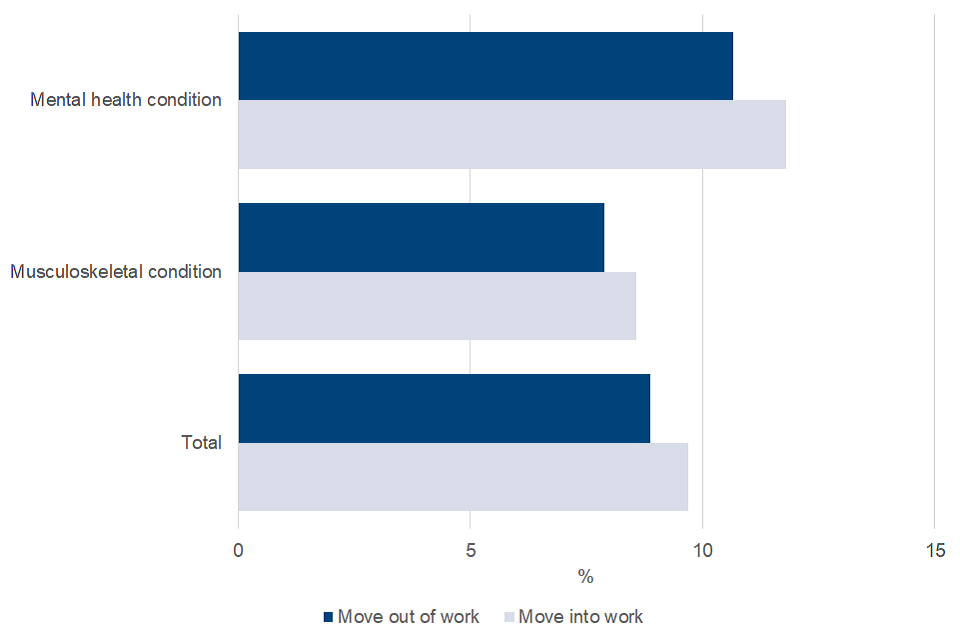
Source: Annual Population Survey – data and definitions can be found in supplementary data tables FLW003 and FLW004
Musculoskeletal (MSK) conditions include problems or disabilities connected with the arms, hands, legs, feet, back or neck. Mental health (MH) conditions include depression, bad nerves, anxiety, mental illness or other nervous disorders.
Data for all health conditions is provided in the supplementary tables should alternative breakdowns be required.
On average between 2014 and 2021, disabled people were more likely to move both in and out of work if their main condition was a mental health condition compared to those where the main condition was musculoskeletal.
-
11.8% of those not in work the previous year with a mental health condition moved into work compared to 8.6% for those with a musculoskeletal condition.
-
10.7% of those in work the previous year with a mental health condition moved out of work compared to 7.9% for those with a musculoskeletal condition.
This is not unexpected given disabled people with a mental health condition are more likely to in the younger age groups (see supplementary data table POP002) and these age groups are more likely to move in and out of work (see supplementary data table FLW005).
Estimates for some health conditions are based on small sample sizes and therefore subject to a higher degree of uncertainty. The data for all health conditions can be found insupplementary data table FLW003. The equivalent data for main or secondary health conditions can be found in supplementary data table FLW004. Unlike in Figure 25 disability status is measured in the first year regardless of whether it changes the following year.
Additional flows data by age, gender and highest qualification can be found in supplementary data tables FLW005 to FLW007.
10. About these statistics
These statistics have been compiled using data from the Labour Force and Annual Population surveys which are produced by the Office for National Statistics (ONS). They follow the same definitions and UK coverage used in the ONS Labour Market Overview. They have been developed using guidelines set out by the UK Statistics Authority and are badged as Official Statistics.
Where to find out more
For more information see the Background information and methodology.
Statement of compliance with the Code of Practice for Statistics
The Code of Practice for Statistics (the Code) is built around three main concepts, or pillars:
-
Trustworthiness – is about having confidence in the people and organisations that publish statistics
-
Quality – is about using data and methods that produce assured statistics
-
Value – is about publishing statistics that support society’s needs for information
The following explains how we have applied the pillars of the Code in a proportionate way.
Trustworthiness
Labour Force Survey, Annual Population Survey data have been produced in line with the Code and are used in highly scrutinised National Statistics publications.
Quality
Several of the key series have been taken directly from a National Statistics publication (Labour Market Overview), produced by the Office for National Statistics (ONS). The data sources used for new analysis in this release are already used for similar analyses in National Statistics publications. The specific analyses included here have been quality-assured, including through peer-review, plausibility checks and validation against other published sources.
Value
This release provides a detailed picture of disability employment up to 2022. It provides important context on the government’s commitment to reduce the disability employment gap, its previous goal to see one million more disabled people in work between 2017 and 2027, and the strategy set out in Improving lives: the future of work, health and disability in November 2017.
Making this information accessible provides Ministers and stakeholders with an overview of disability employment, while helping to reduce the administrative burden of answering Parliamentary Questions, Freedom of Information requests and ad hoc queries.
By comparing high-level estimates from different data sources, this release also provides an evidence base drawing on several different sources, enabling a more rounded picture of broad trends.
Related statistics
The following publications provide additional data, evidence and context on the topics of health, disability and employment.
Access to Work recipients: Statistics on the number of people who had Access to Work provision approved.
Adult Psychiatric Morbidity Survey: Provides data on the prevalence of both treated and untreated psychiatric disorder in the English adult population (aged 16 and over).
Adult Social Care Outcomes Framework (ASCOF): Measures how well care and support services achieve the outcomes that matter most to people.
Coronavirus and the social impacts on disabled people in Great Britain: Indicators from the Opinions and Lifestyle Survey on the social impact of the coronavirus (COVID-19) pandemic on disabled people in Great Britain.
Disability, England and Wales: Census 2021: Information on disability in England and Wales, Census 2021 data.
DWP benefits statistics: National and Official statistics on the main benefits administered by the Department for Work and Pensions (DWP).
Family Resources Survey: An annual report that provides facts and figures about the incomes and living circumstances of households and families in the UK.
Health Survey for England: Monitors trends in the nation’s health and care for adults aged 16 and over, and children aged 0 to 15, living in private households in England.
Households below average income (HBAI) statistics: Statistics on the number and percentage of people living in low-income households in the UK.
Labour market status of disabled people: Labour market status (employment, unemployment and inactivity) of disabled people. This table is updated 4 times a year in February, May, August and November. These estimates are sourced from the Labour Force Survey, a survey of households.
Outcomes for disabled people in the UK: Outcomes for disabled people across areas of life: education, employment, social participation, housing, well-being, loneliness and crime. Analysis by disability status and by age, sex, impairment type and severity, country and region based on survey data.
Personal Independence Payment: Includes numbers of claims in payment, new claim registrations, decisions and awards made.
Work and Health Programme: Statistics on people referred to and starting on the Work and Health Programme.
Contact information and feedback
Authors: Mohammed Adam, Alex Brown and Joella Diong
Lead Statistician: Mark Burley
For more information on disability employment statistics, contact the team at team.workandhealthanalysis@dwp.gov.uk
DWP would like to hear your views on our statistical publications. If you use any of our statistics publications, we would be interested in hearing what you use them for and how well they meet your requirements. Please email DWP at stats-consultation@dwp.gov.uk.
Press enquiries should be directed to the DWP Press Office: 020 3267 5144
Pre-release access
In addition to staff who are responsible for the production and quality assurance of the statistics, up to 24-hour pre-release access is provided to Ministers and other officials. We publish the job titles and organisations of the people who have been granted up to 24-hour pre-release access to the latest disability employment statistics.
Next release
The next annual release of these statistics is expected in Autumn 2023. An exact publication date will be listed in the statistics release calendar.
ISBN: 978-1-78659-451-8
